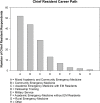The chief resident role in emergency medicine residency programs
- PMID: 20823957
- PMCID: PMC2908642
The chief resident role in emergency medicine residency programs
Abstract
Study objectives: Although other specialties have examined the role of the chief resident (CR), the role and training of the emergency medicine (EM) CR has largely been undefined.
Methods: A survey was mailed to all EM CRs and their respective program directors (PD) in 124 EM residency programs. The survey consisted of questions defining demographics, duties of the typical CR, and opinions regarding the level of support and training received. Multiple choice, Likert scale (1 strong agreement, 5 strong disagreement) and short-answer responses were used. We analyzed associations between CR and PD responses using Chi-square, Student's T and Mann-Whitney U tests.
Results: Seventy-six percent of CRs and 65% of PDs responded and were similar except for age (31 vs. 42 years; p<0.001). CR respondents were most often male, in year 3 of training and held the position for 12 months. CRs and PDs agreed that the assigned level of responsibility is appropriate (2.63 vs. 2.73, p=0.15); but CRs underestimate their influence in the residency program (1.94 vs. 2.34, p=0.002) and the emergency department (2.61 vs. 3.03, p=0.002). The majority of CRs (70%) and PDs (77%) report participating in an extramural training program, and those CRs who participated in training felt more prepared for their job duties (2.26 vs. 2.73; p=0.03).
Conclusion: EM CRs feel they have appropriate job responsibility but believe they are less influential in program and department administration than PD respondents. Extramural training programs for incoming CRs are widely used and felt to be helpful.
References
-
- Grant I, Dorus W, McGlashan T, et al. The chief resident in psychiatry. Arch Gen Psychiatry. 1974;30(4):503–7. - PubMed
-
- Nelson CS, Brown IE, Rao TK. A study of the responsibilities of chief residents in anesthesiology with a suggested job description. Anesthesiology Review. 1994;21(6):199–202. - PubMed
-
- Norris T, Susman J, Gilbert C. Do program directors and their chief residents view the role of chief resident similarly? Fam Med. 1996;28:343–5. - PubMed
-
- Doughty RA, Williams PD, Seashore CN. Chief residency training. Developing leadership skills for future medical leaders. AJDC. 1991;145:639–42. - PubMed
-
- Wortman RL, Costrini NV, Adams ND. The chief medical residency: a description and recommendations. J of Med Educ. 1982;57(4):288–93. - PubMed


